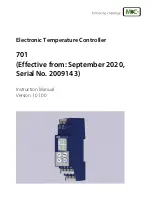
Technichal Manual Heating Actuators AKH
MDT technologies GmbH •
51766 Engelskirchen
• Papiermühle 1
Tel.: +49-2263-
880 • Fax: +49
-2263-4588
• [email protected] • www.mdt.de
31
Option 2:
Cycletime is much smalelr than the adjustment time of the valves
These setting effects, that the valves can not be completely opened or closed between one PWM On
pulse or a Off pulse. So the valve makes only small moves.
Long-term, this setting effects an average of the vavlve-state.
The principle of this option is shown at the diagram below:
Also here, the whole adjustment time is about 3min. But now the valve can only make small steps
during the controlling time. At the beginning, the off-pulse is only as long as dead time and so no
adjustment takes place. So the valve drives continuous open. If the temperature increases the
adjusted value, the temperature controller readjusts the control value and so the PWM pulse is
calculated again. Long-term, an alomost continiuos value is reached.
To note at this setting is, that the dead times are reduced because of the continuous lowing warm
water at the valves. So the real driving times become larger during one controlling process. But
because the temperature controller reacts dynamic, it will adapt the control value and so the nearly
constant position of the valves is reached.
Advantageous of this method is that the valves are not loaded so much. Furthermore the room
temperature is controlled nearly constant by the continuous adaption of the valves.
But if more than one valve is controlled, the average state of the valves is nearly unreachable. So
fluctuations of the romm temperature can occur.
This setting is proven at fast systems, e.g. radiators.
















































